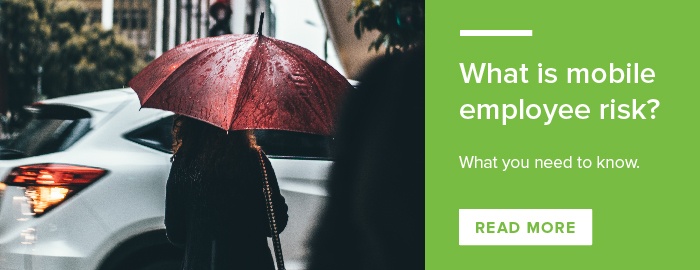We often get asked by company managers or employees who drive for work how much auto insurance they should carry. Different states have different required minimum coverages, but all of these fall short of what's actually needed to protect both employees and employers.
State minimum auto insurance vs. business use of a vehicle
Nearly all fifty states legislate the minimum liability coverages drivers should carry on their vehicles. (New Hampshire and Virginia technically do not require auto insurance but have other laws that essentially force people into obtaining coverage.) While some states have more required types of coverage than others, all at least require three:
- bodily injury liability per person
- bodily injury liability per accident
- property damage liability per accident
These coverage requirements are typically expressed in shorthand as three numbers. If a state requires a 25/50/20 policy, that means a vehicle should be covered for up to $25,000 of bodily injury expenses per person, for up to $50,000 of bodily injury expenses per accident, and for up to $20,000 of property damage expenses per accident. (Here's a list of all state coverage requirements.)
The question is, are state minimum insurance coverage enough if you cause a car accident? The answer depends on how bad the accident is. If you cause an accident that sends five people to the hospital, the medical bills can exceed $50,000 pretty quickly.
This is why insurance agents recommend higher coverage than the minimum car insurance required by most states. Employers should also set minimums for their employees' auto insurance coverage if those employees drive personal vehicles for business purposes.
Company liability for employee auto accidents
If your business owns any vehicles used for the business, then getting business vehicle insurance is a no-brainer. This insurance coverage will probably be pretty robust, often around $1 million per incident, especially if the company operates a fleet of vehicles.
But what about organizations with employees who operate personal vehicles to visit clients, make sales calls, travel between job sites or offices, run errands, or make deliveries? These organizations can face unexpected liability for employee-caused accidents.
This liability arises when an employee causes an accident while doing their job, and their personal auto insurance coverage is insufficient to cover the bodily injury expenses or property damage. In that case the victim's insurance company will sue the employer to recover the balance of those costs.
To protect your business, it is necessary to require employees to maintain auto insurance sufficient to fully cover an employee-caused accident.
How much car insurance should employees carry on personal vehicles?
The bottom line is, do not rely on state minimum insurance coverage for yourself or for your employees. Your company should maintain a policy that requires all employees to carry significantly higher coverage. We recommend a 250/500/100 policy to fully protect both workers and employers.
The bare minimum is a 100/300/50 policy. But often the difference in premium costs between the two coverage levels is insignificant, so the higher coverage is worth it. It is also wise for employers to include in their business vehicle insurance policy coverage for all vehicles used on behalf of the company, not just the ones owned by the company. That way, if an employee's insurance coverage ever lapses and an accident occurs, the employer still has a way to cover any liability.
For employees – if you drive a personal vehicle for work but there's no requirement of insurance beyond the state minimum, you should obtain a higher level of coverage. Talk to management about being reimbursed for the higher premium, since the company benefits from decreased liability from any accident involving your vehicle.
How to help employees obtain higher auto insurance coverage
Since it is in the best interest of the company to require all employees to maintain high levels of insurance coverage, it is important to do three things to ensure compliance:
-
Create a written policy stating the required minimum car insurance.
The policy should unequivocally state the required minimum level of coverage (preferably 250/500/100, as well as coverage for collisions with uninsured and underinsured motorists).
-
Verify minimum car insurance coverage every six months.
On a bi-annual basis, require employees to submit their auto insurance declarations page from their most recent policy renewal as a condition of receiving their car allowance or vehicle reimbursement.
-
Reimburse employees for the business portion of their auto insurance premiums.
Compensate for the increased insurance premium by boosting the company car allowance or vehicle reimbursement plan – this needs to be a win-win situation, not a point of contention. A fair calculation of the business portion is five-sevenths (5/7), since employees generally work five out of seven days.
Our eBook on mobile employee risk can give you more details on how to think through and set up these procedures.
Preventing employee-involved vehicle accidents
There are other ways of reducing insurance liability for employee vehicle accidents. The most important is to create a driver safety program that both helps to prevent employee accidents and to protect the company from a negligent entrustment lawsuit if an accident occurs.
If an employer has a driver on the road, whether operating a company vehicle or a personal vehicle, the employer can be held responsible for the employee's actions via the legal doctrine of respondeat superior. However, by maintaining policies that incentivize safe driving and use motor vehicle record checks to determine whether a driver should be on the road, an organization can protect itself from liability. (Read our guide to establishing a driver safety program.)
For help writing a new policy on employee auto insurance, carrying out insurance verification, or setting up a driver safety program, contact an mBurse representative or visit our Professional Services page. Learn more about ways to reduce overall company risk from employees traveling in personal vehicles through our Guide to Mobile Employee Risk.


